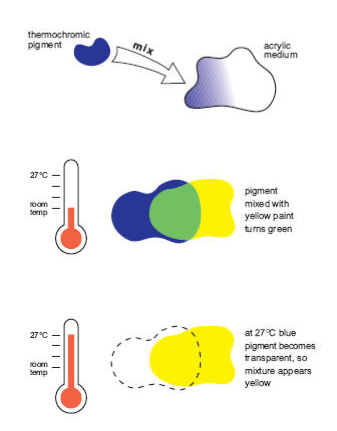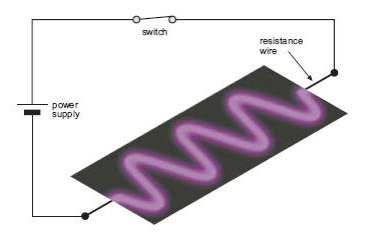Thermochromism
Thermochromism is the ability of substance to change color due to a change in temperature. A mood ring is an excellent example of this, but it has many other uses such as baby bottles (changes to a different color when cool enough to drink) and kettles. Thermochromism is one of several types of chromism.
More about Thermochromic paints
THERMOCHROMIC PIGMENTS Thermochromic materials change colour at specific temperatures. Typically, they are incorporated into a special ink and printed onto plastic films to create thermometers or temperature indicators. The battery test strip is a good example. If the battery is in good condition, current flows through a printed resistor under the thermochromic film and heats it to cause a colour change.
Most thermochromic materials are based on liquid crystal technology. At specific temperatures the liquid crystals re-orientate to produce an apparent change of colour. The liquid crystal material itself is microencapsulated- i.e., contained within microscopic spherical capsules typically just 10 microns in diameter. Billions of these capsules are mixed with a suitable base to make thermochromic printing ink or, for example, with plastics destined for injection moulding. The thermochromic pigment in the Smart Colours system is made up as a liquid paste compatible with any acrylic media. It is available in four colours plus black:
The base or carrier supplied for the Smart Colours pigments is an acrylic medium that is particularly suitable for application to paper, plastics and fabrics. However, the pigments can also be mixed with practically any acrylic paint. Trial and error will determine the proportions of the mixture.
The creative opportunities really begin when the pigments are mixed with acrylic paints of different colours. For example, if blue pigment is mixed with yellow acrylic paint, the resulting colour is green. But at 27°C, the blue hue disappears and the green changes to yellow! There are, of course, an infinite number of possible colour variations.
USING THE THERMOCHROMIC PIGMENT: Its a good idea to begin by creating a test/demonstration strip on paper or plastic sheet (e.g. a thin walled plastic cup). Mix a small amount of pigment into the acrylic base and dilute with water, if necessary, so it can be applied with a small paint brush. The painted surface should be left to dry in a warm place, where the colour-change effect will become apparent even before drying is complete. If your samples are painted onto a thin walled plastic cup which is then filled alternately with hot and cold water, the colour change is immediate and dramatic.
APPLICATIONS The Smart Colours range of pigments are formulated for a colour change at near body heat (which makes them ideal for garments that change colour when worn or touched). In general, the pigments can be used for any application where a temperature warning is needed, e.g., drinking cup, hot surface warning, food storage. The illustration shows a visual display idea based on the use of resistance wire behind a sheet of purple coloured paper covered with black thermochromic pigment. Where the wire heats up the pigment, the purple starts to show through. This principle can be used to create a message display or, for example, a battery or fuse tester.
IMPORTANT POINTS TO REMEMBER:
- If painting or printing onto fabrics use only the acrylic medium supplied within the system. This is ideal for screen printing as well as hand painting or stencilling.
- Use only the minimal amount of pigment for the desired colour.
- Dilute the acrylic carrier with water if necessary - but keep mixing periodically to prevent separation of pigment and acrylic.
- Take all normal precautions when using chemicals. Handle in accordance with good industrial hygiene and safety practice - e.g., use in a well ventilated area and wear disposable gloves.
Chromism
In chemistry, chromism is a process that induces a change, often reversible, in the colors of compounds. In most cases, chromism is based on a change in the electron states of molecules, especially the π- or d-electron state, so this phenomenon is induced by various external stimuli which can alter the electron density of substances. It is known that there are many natural compounds that have chromism, and many artificial compounds with specific chromism have been synthesized to date.
Chromism is classified by what kind of stimuli are used. The major kinds of chromism are as follows.
- thermochromism is chromism that is induced by heat, that is, a change of temperature. This is the most common chromism of all.
- photochromism is induced by light irradiation. This phenomenon is based on the isomerization between two different molecular structures, light-induced formation of color centers in crystals, precipitation of metal particles in a glass, or other mechanisms.
- electrochromism is induced by the gain and loss of electrons. This phenomenon occurs in compounds with redox active sites, such as metal ions or organic radicals.
- solvatochromism depends on the polarity of the solvent. Most solvatochromic compounds are metal complexes.
- cathodochromism is induced by electron beam irradiation.

